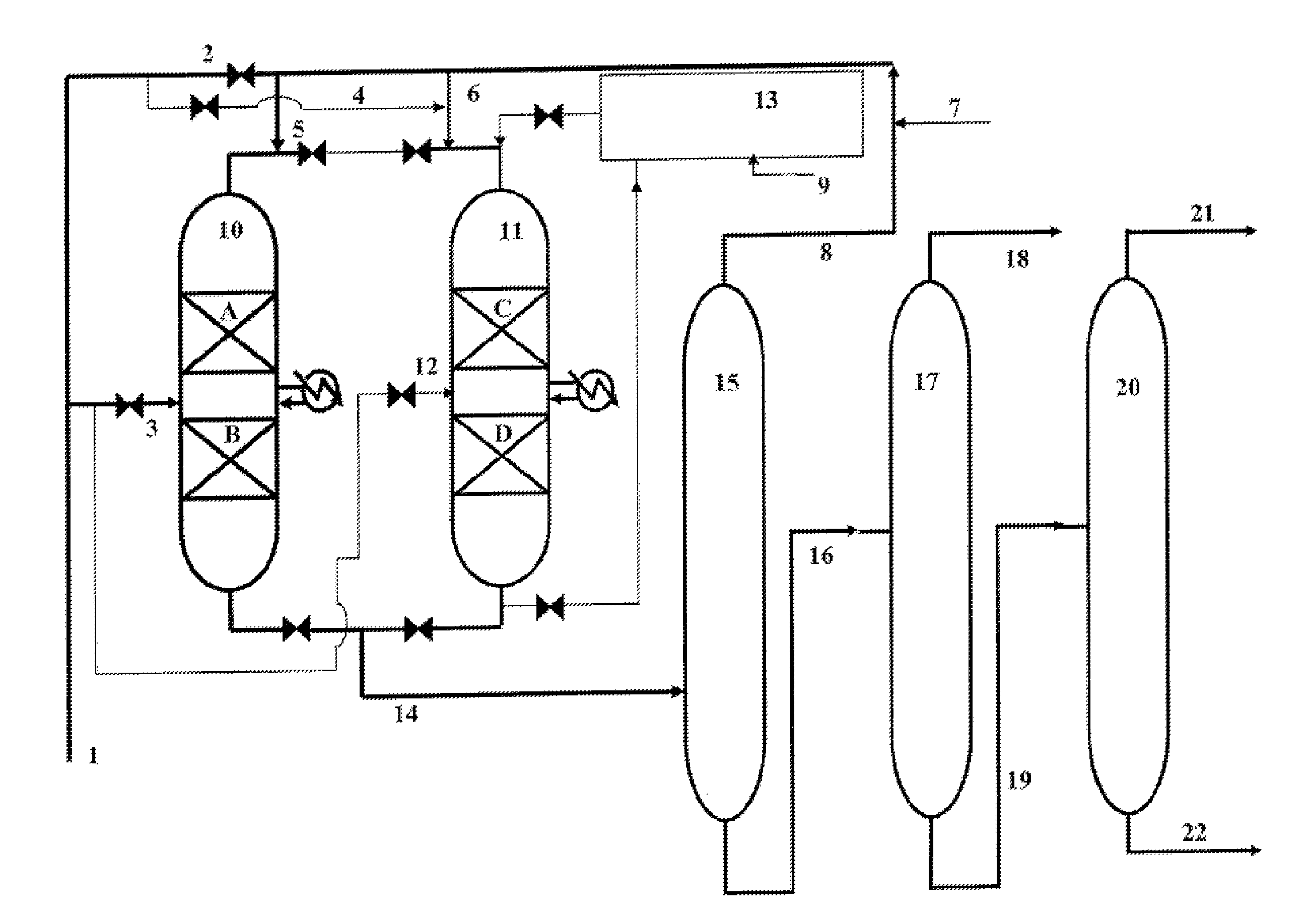Process for the production of phenylalkanes that uses at least two alkylation reactors in parallel
a technology of alkylation reactor and phenylalkane, which is applied in the direction of organic chemistry, transportation and packaging, hydrocarbon preparation catalysts, etc., can solve the problems of difficult implementation, waste removal, and severe safety problems, and achieve the effect of limiting the deactivation and considerably prolonging the cycle duration of the alkylation reaction
- Summary
- Abstract
- Description
- Claims
- Application Information
AI Technical Summary
Benefits of technology
Problems solved by technology
Method used
Image
Examples
example 2
Preparation of Catalyst B Containing a Mordenite Zeolite
[0065]A mordenite zeolite in sodium form, whose chemical formula in the anhydride state is Na1AlO2(SiO2)5.1 and its sodium content is 5% by weight, is used. 100 grams of this powder is brought to reflux at 100° C. for 2 hours in a 4N ammonium nitrate solution with a V / P ratio that is equal to 4 cm3 / g. This cationic exchange operation is repeated 3 times. The content by weight of sodium of the product that is obtained is about 500 ppm (parts per million).
[0066]This product is then subjected to an acid attack using a 4.5 N nitric acid aqueous solution, and the product is brought to reflux in this aqueous solution for 2 hours with a V / P ratio that is equal to 4 cm3 / g. After this treatment, the product is washed with demineralized water.
[0067]The mordenite that is obtained has an Si / Al atomic ratio that is equal to 40 and a sodium content that is equal to 20 ppm by weight.
[0068]The thus obtained mordenite is then mixed with an alum...
example 3
Production of Phenylalkanes (According to the Invention)
[0069]Two catalytic reactors 1 and 2 in parallel, each comprising two reaction zones that contain 25 cm3 of catalyst A in the form of extrudates, prepared according to Example 1, are used.
[0070]The reactor 1 is in alkylation phase. The reactor 2 is in rejuvenation phase.
[0071]For the reactor 1, the operating conditions for the alkylation of the benzene for each reaction zone are the following:[0072]Temperature: 120° C.[0073]Pressure: 4 MPa[0074]VVG close to 2 h−1 (volume of liquid hydrocarbons per volume of catalyst and per hour)[0075]Molar ratio {benzene / dodecene−1} in each of the reaction zones≈60
[0076]A feedstock that contains 86% by weight of benzene and 14% by weight of olefins (C10-C14) is prepared. This feedstock that is introduced at the inlet of the first reaction zone contains all of the benzene that is necessary for the alkylation reaction and half the amount of olefins necessary for the alkylation reaction. The othe...
example 4
Production of Phenylalkanes (According to the Invention)
[0086]Example 3 is used again except for the nature of the acidic solid catalysts that are used. Each of the two reaction zones of each of the reactors 1 and 2 contains a catalyst that consists of a mixture of 50% by weight of catalyst A based on dealuminified Y zeolite and 50% by weight of catalyst B based on mordenite zeolite.
[0087]The operating conditions of the alkylation reaction are identical to those used in Example 3. The results that are obtained are presented in Table 2.
[0088]
TABLE 2Cycle Duration with Conversion of Olefins >95%39 hoursLinearity of the Product Obtained (% by Weight)93.5Composition of the Product (% by Weight)2-Phenylalkane50.13-Phenylalkane24.64-Phenylalkane9.25-Phenylalkane4.66-Phenylalkane3.7Didodecylbenzene (% by Weight)6.8Heavy Residue (% by Weight)1.2
[0089]The selectivity of 2-phenylalkane is equal to 50% by weight versus only 28.3% by weight in the case of Example 3. The selectivity of a particu...
PUM
| Property | Measurement | Unit |
|---|---|---|
| molar ratio | aaaaa | aaaaa |
| molar ratio | aaaaa | aaaaa |
| molar ratio | aaaaa | aaaaa |
Abstract
Description
Claims
Application Information
 Login to View More
Login to View More - R&D
- Intellectual Property
- Life Sciences
- Materials
- Tech Scout
- Unparalleled Data Quality
- Higher Quality Content
- 60% Fewer Hallucinations
Browse by: Latest US Patents, China's latest patents, Technical Efficacy Thesaurus, Application Domain, Technology Topic, Popular Technical Reports.
© 2025 PatSnap. All rights reserved.Legal|Privacy policy|Modern Slavery Act Transparency Statement|Sitemap|About US| Contact US: help@patsnap.com


